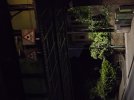From the original photo, there are light units above the signs, so obviously the council in the past decided that the signs should be lit. So it is up to the council to get that sorted, not the railway. I've no idea who UK power networks are, I suspect the local electricity supply company, so it may be the case that the supply has been lost. Again up to the council to push this.
On the other side of the problem, items fixed to railway bridges cause all sorts of issues. I had cause to replace bridge height signs a few years ago, negotiations with Network Rail took ages, they needed details of the fixings for the signs, how the electricity supply cable was to be fixed to the structure, safe systems of work, method statements, plans and service diagrams etc. etc. In all it took the best part of 6 months to sort it, and then we had to have an official road and rail closure to carry out the work, with NR on site to oversee the work which took the grand total of 3 hours! This was done on a Sunday morning. Oh, and the railway only had one train each way a day, and non on Sundays, the Stocksbridge steels branch in Sheffield.
So it could be that your council is trying to fix things, but bogged down in the never ending saga of paperwork.
Of course if there is a bridge bash at night and the defendant says the signs weren't lit, things will probably get sorted much quicker!


